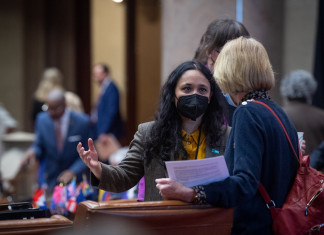The question of who’s got the artifacts from a local archaeological dig surfaced again, this time in Rhinebeck.
But despite the town historian’s concern, the town supervisor says the town is glad to have Bard College storing the pieces—for now.
Rhinebeck Town Historian Nancy Kelly raised the issue at the June 9 town board, after presenting board members with a story in The Observer on a Hyde Park archaeological dig in which unearthed artifacts still have not been returned to the town by the Bard professor who led the project.
Kelly then discussed her concern about artifacts that were unearthed during a costly archeological dig conducted several years ago at the Thomas Thompson-Sally Mazzarella Park.
The state-mandated excavation process, which was led by Bard archaeologist Christopher Lindner, culminated in an official report on arrowheads and other American Indian artifacts that were found at the site, some of which potentially date back as far as 5,000 years, Kelly told the town board.
But, she added, the artifacts never found their way back to Rhinebeck, and are still being held at Bard.
“These are things that belong in Rhinebeck” she contended.
“There’s been some bad experiences with other situations like this,” Kelly added, pointing to the Observer story.
Lindner, the director of the Bard Archaelogy Field School, is the key player in a disagreement with the town of Hyde Park and the Dutchess County Historical Society. Both have sent him letters requesting the return of artifacts unearthed between 2000 and 2007 at the Hyde Park site of the Guinea Community, an enclave of free slaves dating back to the late 1700s.
Neither Kelly nor Rhinebeck Town Supervisor Elizabeth Spinzia referenced Lindner by name in the board discussion of Rhinebeck’s artifacts.
But Spinzia, who is an alumna of Bard, assured Kelly that a formal letter requesting the return of the artifacts could be drafted from the town board to Bard.
She also noted that she had recently met with the “professor in question,” and seemed confident that the artifacts would be returned, as long as there was an adequate storage facility to house them.
Kelly assured Spinzia at the meeting that the artifacts could be safely stored upon their return. But in a later interview with the Observer, Kelly said the town is currently looking into “a suitable spot in Rhinebeck where [the artifacts] can be stored for the foreseeable future.”
She added, “Ideally, there will be a community center at the Thompson-Mazzarella Park, where they can be displayed.”
According to Spinzia, there are state requirements for storing artifacts such as these and currently Rhinebeck is without a suitable option.
“If we can find a facility that meets the standards set by the New York State Office of Parks, Recreation and Historic Preservation, we will ask for the artifacts back, but until then, Bard College is doing us a favor by housing them and we are grateful to Professor Lindner, and to Bard,” she told the board meeting.
Spinzia later told the Observer that no formal letter would be sent to Bard.
According to the Bard archaeological website, the Rhinebeck park dig, which involved Bard students and community volunteers, revealed “colonial artifacts [that] indicate the start of Rhinebeck village nearby, while side-notched projectile points range in age from 3,000 to 5,000 years. Hide scrapers and spear-thrower weights have also been found.”
And in a December 2009 letter to the Rhinebeck Science Foundation, Lindner wrote about 85 fourth graders from Chancellor Livingston School who visited the dig for a day.
“Students successfully excavated in two trenches and sifted soil to discover artifacts,” he wrote. “I have brought back to my lab charred bones, fire-cracked rocks and some potential stone tools for further examination. I’ll keep the students posted about their findings.”
According to Sally Mazzarella, one of the key proponents of the park, the dig cost the town of Rhinebeck $100,000.
But, she told the Observer, the dig itself was very positive for the town. “We learned a lot about our heritage and culture. The digs offered our youth an opportunity to get involved and learn about the importance of archaeology and the history of our community,” she said.







Facebook Comments